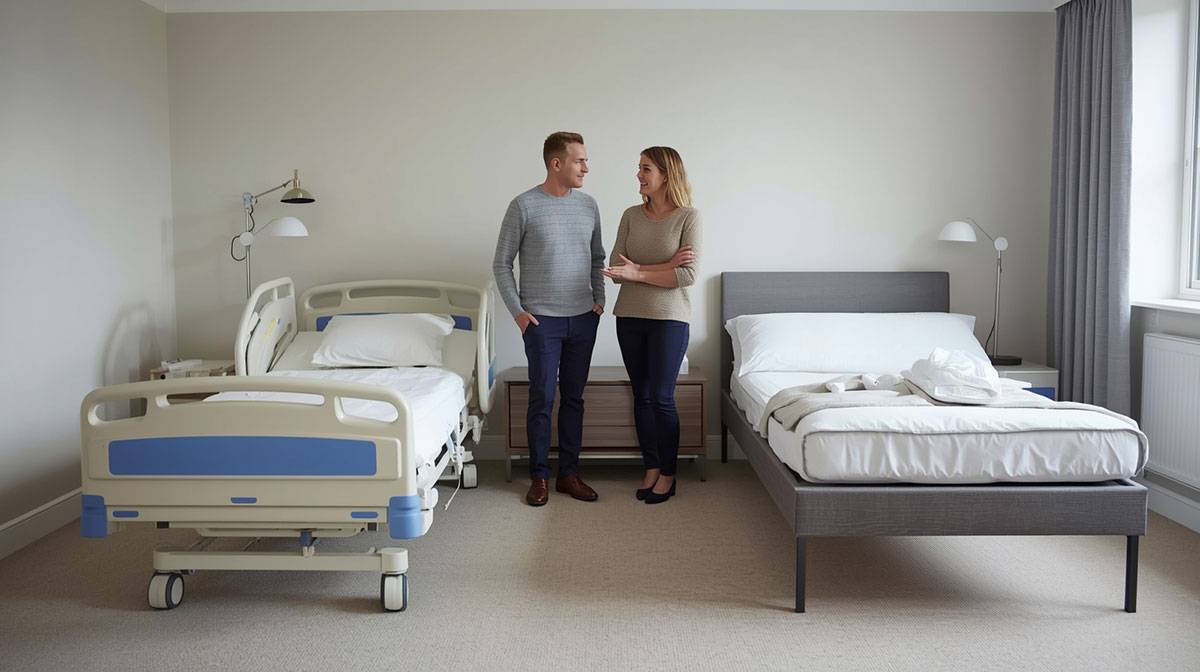Hospital Beds vs. Adjustable Beds: What Homeowners Don’t Realize
Many families think an adjustable bed is the same as a hospital bed. Both look similar. Both raise the head and feet. Both offer comfort. But they serve entirely disparate purposes. Comparing them side by side, you begin to understand why the hospital bed is often the better option for long-term care at home.
This guide breaks down what homeowners don’t typically notice. It also allows you to judge when an adjustable bed makes sense and when you actually need a hospital bed.
1. Hospital Beds Are Built for Care. Adjustable Beds Are Built for Comfort.
A value in a bed is about comfort. It makes sleeping easier, TV watching more relaxing or snoring less? It offers lifestyle benefits. It is not, however, made for medical use.
A safer, caring, and mobile room to a hospital bed. It is a transfer aid for those who require assistance getting in and out of bed. It’s a lifeline to seniors in danger of taking a tumble. It is the way to make a stay to put things such that you are simultaneously free, free to breathe and in circulation.
These differences do matter when you’re taking care of someone at home. You can hit a lot of “hospital bed for sale” results online, but actual medical beds are built for patient support — not to sleep in.
2. Height Adjustment Makes a Huge Difference
Many people don’t realize this. The adjustable beds are not for dropping to the floor. They lift only the head and the foot.
A hospital bed sinks nearly to the floor and rises high enough for safe caregiving. This serves as a protector for the patient and the caregiver.
Lower height helps:
- Prevent falls
- Make the patient feel secure
- Allow safer transfers
Higher height helps:
- Reduce back strain for caregivers
- Make dressing and cleaning easier
- Support physical therapy or repositioning
In many cases, families may opt for an adjustable bed because they consider it to be “good enough.” But when a hospital bed is needed for raising and lowering the head or feet (or both), they are most likely grateful to have it.
3. Hospital Beds Have Locking Wheels for Mobility
Adjustable beds are mounted on a stationary frame. They are bulky, and the movement is not super-easy.
Beds in a hospital are designed to move. They are equipped with strong medical-grade casters with a full locking mechanism. You can move the bed for:
- Cleaning
- Rearranging the room
- Bringing medical equipment closer
- Moving the patient to an alternate room
This flexibility is one of the overlooked things that makes a massive difference.
4. Side Rails Are Not Optional—They’re Essential for Safety
Many families experiment with third-party rails on an adjustable bed. This is unsafe.
Adjustable beds don’t have built-in rails. Hospital Beds with Engineered Sets of Side Rails. These are side rails that lock in place and remain locked.
Side rails help with:
- Preventing falls
- Offering gripping assistance while you sit up
- Turning or repositioning
- Independence for those with little strength to spare
If your safety is at the top of the list when considering a home care bed, then an electric hospital bed for sale with these proper precautions is what you need because it doesn’t need to be added on.
5. Weight Capacity and Durability Are Completely Different
The Perfect Sleeper is the best-built bed in its price range. Made specifically for RTG or other retailers for a no-hassle experience, it is not recommended for everyday general use. Their motors and frames are not meant to withstand the strains of medicine.
The function of hospital beds is to provide:
- Heavier weight
- Repetitive adjustments
- Constant caregiving activity
- Durable cleaning requirements
The frames are steel. The motors are medical-grade. For infection control, the surfaces are formulated.
This is important for long-term care, recovery from surgery or care of the elderly.
6. Mattresses Are Not the Same
An adjustable bed has a foam or hybrid mattress. It’s not recommended for people who have bedsores or mobility problems.
Hospital beds have mattresses made out of:
- Pressure-relief foam
- Alternating-pressure air mattresses
- Low-air-loss systems
The mattresses help to prevent skin breakdown, promote better blood flow and reduce pain.
You cannot put a therapeutic mattress on an ordinary adjustable bed. It will not properly lie, and the safety rails will not meet.
7. Hospital Beds Are Designed for Medical Accessories
This is an aspect of house-owning that few ever think about.
Among the medical accessories that can be used with a hospital bed are:
- Over-bed tables
- Trapeze bars
- IV poles
- Lift devices
- Air mattress pumps
- Bed alarms
These gadgets are not designed to work with adjustable beds.
If you anticipate needing to add equipment later, start with a hospital bed.
8. Which One Should You Choose?
Here is a simple guide:
Choose an Adjustable Bed if:
- The user is mobile
- The goal is comfort or sleep improvement
- There is no fall risk
- No caregiver is needed
Choose a Hospital Bed if:
- The user needs help getting in or out of bed
- There is a fall risk
- Breathing, digestion, or circulation needs support
- The patient is recovering from surgery
- A caregiver assists daily
- You need rails, medical mattresses, or mobility
Many families begin with an adjustable bed, only to learn that it’s safer and more useful as the disease advances, just to have a hospital bed.
Final Thoughts
If you’re comparing hospital beds to adjustable beds, these two types of beds aren’t the same at all when we are talking about their use and performance. For medical purposes, home care, senior care or long-term rehabilitation, a hospital bed is an ideal solution.
If you are considering your choices right now and trying to determine if you need a “hospital bed for home”, divert your attention to modern models that feature full electric power, safety rails, a medical mattress, and longevity. Some providers also have an electric hospital bed for sale, perfect for a family looking to experience easy height adjustments and secure positioning.
The proper bed selection can make all the difference in comfort, fall risk, and quality of life for the patient and caregiver. And if you want help finding the right model, I can walk you through models that may be best for your particular mobility needs, budget or home layout.



